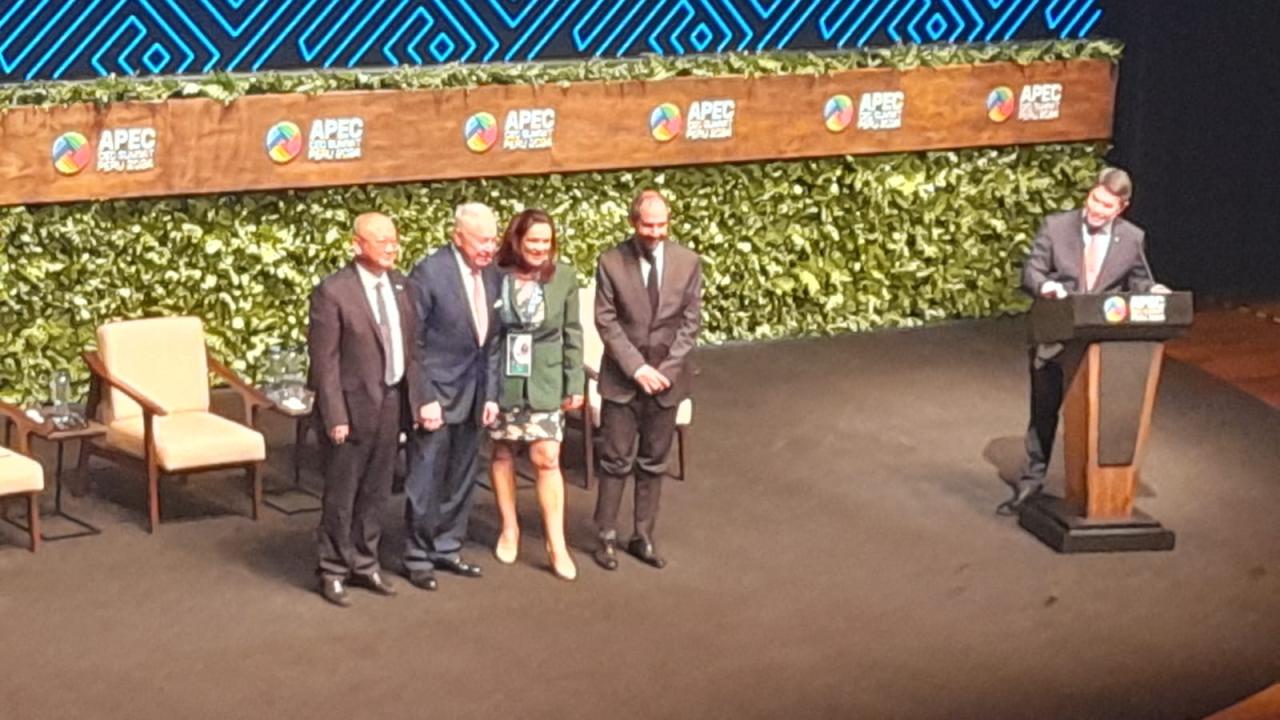
With demand for copper increasing globally, executives recognize the need for methods to reduce electricity costs and CO2 emissions in equal parts.
“If you look at an electric car, it involves a lot more metals than a diesel car. So, we are entering a new era in which we are going to need more mining.” This was the slogan of the Summit Focused on Energy Transition, organized this Thursday, November 14, within the framework of the APEC CEO Summit Peru 2024 in Lima. The conversation between entrepreneurs of multiple nationalities addressed the key role of minerals in the global transition to renewable energies.
It is worth noting that copper is one of the most sought-after metals in this process, due to its role in the installation of smart power grids, as well as in the electrification of transport. Richard Adkerson, president of the mining company Freeport McMoRan , revealed that the red metal has gained prominence in the global economy, due to geopolitical reasons.
“Two decades ago, we started a large mine on the Indonesian island of New Guinea, which is now the second largest copper mine in the world. For many years it was also the largest gold mine as a by-product. We didn’t know where to take the company. But since copper was tied to the global economic cycle, everything changed when China became a dominant consumer of the metal,” he explained.
The rapid technological and industrial development of the Asian dragon boosted demand for copper, which boosted the exploration of deposits in regions such as South America. Not all mines were equally difficult to exploit, so Freeport saw an opportunity to bet on copper.
“Two-thirds of copper goes into electricity generation, transmission or use. Look at your own homes, your communications devices or artificial intelligence. What will it take to provide power and AI uses?” Adkerson asked.
On the other hand, the executive acknowledged the need for this exploitation to be accompanied by a reduction in the carbon footprint. As an example, Adkerson highlighted the Cerro Verde mine, located in the Peruvian department of Arequipa.
Freeport processes more than 400,000 metric tons of rock a day. To reduce environmental impact, the company is building a new tailings containment facility. Adkerson was quick to say the project will be “the tallest earthen dam ever built in history.”
Along the same lines, the executive highlighted Copper Skies, an initiative applied in mines in the southwestern United States where Freeport uses solar and wind energy, also working with local suppliers. “Hydroelectric energy is also an important resource. We are using diesel-electric haul trucks in Peru and exploring options to electrify these vehicles, which is a huge challenge. Changing our energy sources and managing the use of explosives is complex,” clarified Adkerson.
On the other hand, the sustainable approach can be present in unexpected areas, as demonstrated by the case of Enaex, a Chilean company dedicated to explosives and blasting services in mining. With operations in 12 countries and more than 5,000 employees, the corporation has ventured into the production of “green ammonia.” This compound is obtained by splitting water molecules through electrolysis, which generates green hydrogen. The latter is combined with nitrogen to produce ammonia without CO2 emissions.
In Peru, this process is manifested in the Cachimayo plant, located in the department of Cusco. There, in March 2024, Enaex revealed that 8.6 tons of green hydrogen were produced daily. “The plant has been certified. So, at this moment, we can produce the first green ammonia in the world. Then we can manufacture ammonia as a fertilizer, which is also the main material in this process,” explained Juan Andrés Errázuriz, CEO of Enaex, during his speech. In this way, the company currently produces green ammonia both to manufacture explosives and to sell it to other industries.
SOLAR ENERGY
And naturally, there are also multinationals that focus on renewable energy production. This is reflected by Li Zhenguo, founder and president of LONGi Green Energy , one of the largest solar energy companies in the world. They have been involved in the power grid industry for three years, which is dedicated to purifying green electricity through water.
“We are very proud to have led and promoted technological progress and cost reduction in the electricity industry over the past decade in most countries and regions around the world. We can point out that when we produce solar panels, we also use copper. We are very concerned about the purification of the metal during the mining process, as the solar panel emits less CO2 and contributes to decarbonization,” said Li.
The Chinese executive then explained the greatest assets of solar energy: for a start, it converts the electricity used in mining into green energy. This is based on the premise that in remote areas, electricity is expensive, so diesel generators are often used that emit high carbon emissions, which can be avoided with solar panels. In addition, Li says that a micro-electric grid can be built in the mines, which further reduces costs.
The CEO of LONGi later agreed with Errázuriz that green electricity is useful for manufacturing explosives without carbon emissions. “Finally, our solar panels can help mine rehabilitation, covering waste areas and managing stormwater runoff to protect the environment,” Li added.









